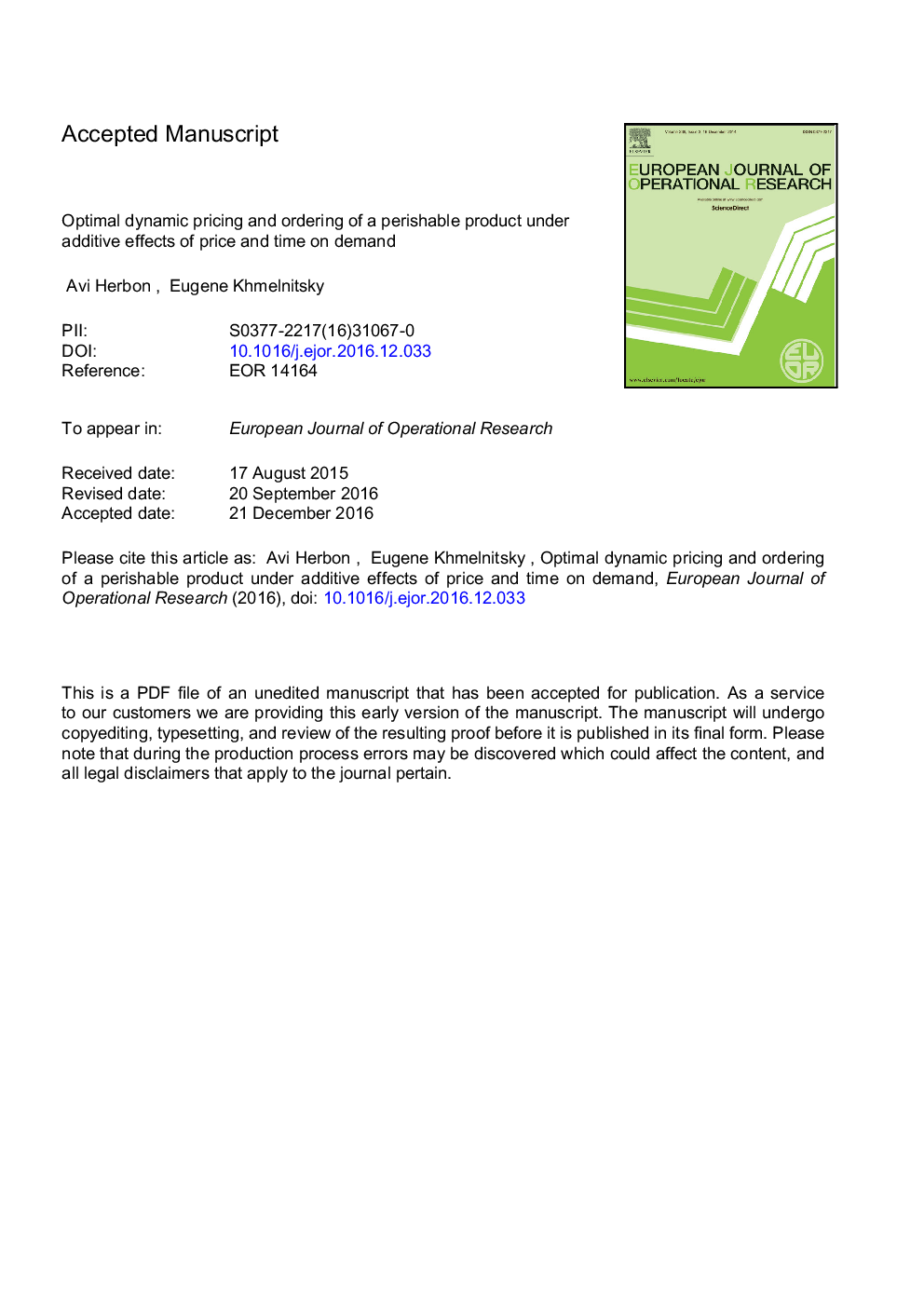| کد مقاله | کد نشریه | سال انتشار | مقاله انگلیسی | نسخه تمام متن |
|---|---|---|---|---|
| 4959848 | 1445956 | 2017 | 32 صفحه PDF | دانلود رایگان |
عنوان انگلیسی مقاله ISI
Optimal dynamic pricing and ordering of a perishable product under additive effects of price and time on demand
ترجمه فارسی عنوان
بهینه قیمت گذاری پویا و سفارش محصول فاسد شدن تحت تاثیرات افزایشی قیمت و زمان تقاضا
دانلود مقاله + سفارش ترجمه
دانلود مقاله ISI انگلیسی
رایگان برای ایرانیان
کلمات کلیدی
فهرست، قیمت گذاری پویا، سیاست قیمت گذاری دیفرانسیل، تقاضای افزودنی، آیتم های سریع
ترجمه چکیده
هنگامی که محصولات فاسد شده مانند محصولات لبنی، میوه ها و سبزیجات، مواد مخدر یا باتری ها به صورت یکنواخت قیمت داده می شوند، بدون در نظر گرفتن مقدار زمان باقیمانده تا زمان انقضا، مصرف کنندگان می توانند به سمت محصولات تازه تر حرکت کنند و برخی از موجودی ها را از دست ندهند. یک سیاست قیمت گذاری پویا، که در آن قیمت محصولات به صورت انحصاری با قیمت گذاری متفاوت می شود، مشتریان را تشویق به خرید محصولات تازه تر، افزایش درآمد و حذف ضایعات می کند. به دنبال منابع کمیاب قیمت گذاری پویای اقلام فاسد قابل ذخیره، این مقاله یک مدل برای تعیین برنامه به روز رسانی مطلوب محصول و قیمت پویا در طول زمان با هدف به حداکثر رساندن سود خردهفروشی ایجاد می کند. تقاضای مشتری فرض می شود که یک تابع شبیه افزایشی قیمت و زمان پس از دوباره سازی است. برخی از خواص سیاست قیمت گذاری و بهینه سازی بهینه با استفاده از شرایط لازم و کافی از بهینه سازی به دست آمده است. تعدادی از نمونه ها نشان می دهد که پویایی سیاست بهینه تحت فرض های مختلف در مورد تقاضا. به طور خاص، ما اندازه گیری می کنیم که خرده فروش می تواند از اجرای یک سیاست قیمت گذاری پویا در مقایسه با یک استاتیک بهره مند شود، و ما نشان می دهیم که سیاست مطلوب به شدت وابسته به شکل تقاضا در مدل است.
موضوعات مرتبط
مهندسی و علوم پایه
مهندسی کامپیوتر
علوم کامپیوتر (عمومی)
چکیده انگلیسی
When perishable products, such as dairy products, fruits and vegetables, drugs, or batteries are priced uniformly, without taking into consideration the amount of time remaining until the expiration date, consumers may gravitate towards fresher products, leaving some inventory unsold. A dynamic pricing policy, in which products are priced differently as they approach expiration, may encourage customers to buy less-fresh products, potentially increasing revenue and eliminating waste. Following scarce literature on dynamic pricing of storable perishable items, this paper develops a model to determine a product's optimal replenishment schedule and dynamic price over time, with the aim of maximizing the retailer's profit. Customer demand is assumed to be a pseudo-additive function of price and time since replenishment. Some properties of the optimal pricing and replenishment policy are derived by means of necessary and sufficient conditions of optimality. A number of examples show the dynamics of the optimal policy under different assumptions regarding demand. In particular, we evaluate the extent to which the retailer can benefit from the implementation of a dynamic pricing policy as opposed to a static one, and we show that the optimal policy is highly dependent on the form of demand incorporated into the model.
ناشر
Database: Elsevier - ScienceDirect (ساینس دایرکت)
Journal: European Journal of Operational Research - Volume 260, Issue 2, 16 July 2017, Pages 546-556
Journal: European Journal of Operational Research - Volume 260, Issue 2, 16 July 2017, Pages 546-556
نویسندگان
Avi Herbon, Eugene Khmelnitsky,
